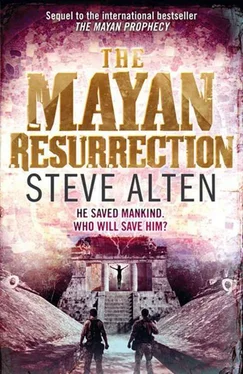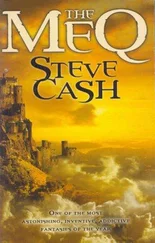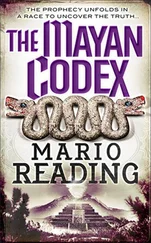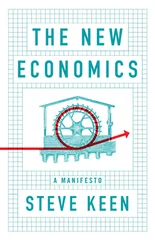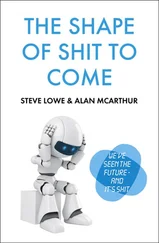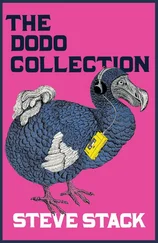Steve Alten - The Mayan Resurrection
Здесь есть возможность читать онлайн «Steve Alten - The Mayan Resurrection» весь текст электронной книги совершенно бесплатно (целиком полную версию без сокращений). В некоторых случаях можно слушать аудио, скачать через торрент в формате fb2 и присутствует краткое содержание. Жанр: Триллер, на английском языке. Описание произведения, (предисловие) а так же отзывы посетителей доступны на портале библиотеки ЛибКат.
- Название:The Mayan Resurrection
- Автор:
- Жанр:
- Год:неизвестен
- ISBN:нет данных
- Рейтинг книги:3 / 5. Голосов: 1
-
Избранное:Добавить в избранное
- Отзывы:
-
Ваша оценка:
- 60
- 1
- 2
- 3
- 4
- 5
The Mayan Resurrection: краткое содержание, описание и аннотация
Предлагаем к чтению аннотацию, описание, краткое содержание или предисловие (зависит от того, что написал сам автор книги «The Mayan Resurrection»). Если вы не нашли необходимую информацию о книге — напишите в комментариях, мы постараемся отыскать её.
The Mayan Resurrection — читать онлайн бесплатно полную книгу (весь текст) целиком
Ниже представлен текст книги, разбитый по страницам. Система сохранения места последней прочитанной страницы, позволяет с удобством читать онлайн бесплатно книгу «The Mayan Resurrection», без необходимости каждый раз заново искать на чём Вы остановились. Поставьте закладку, и сможете в любой момент перейти на страницу, на которой закончили чтение.
Интервал:
Закладка:
On December 15, 2029, HOPE’s first ‘space bus’ took off down its new fifteen-thousand-foot runway. On board were 120 passengers, including key stockholders, political dignitaries, a dozen members of the media, and a crew of twelve.
Nothing real or imagined could have prepared these civilians for the magic of space. The sixteen-hour flight was smooth, the service first-class (just eating in zero gravity an experience unto itself) and the view-well, the view was both spiritual and humbling.
Within two months, HOPE was shuttling four space buses a week at a cost of $100,000 per ticket. Even with its high price tag, there was still a fourteen-month wait.
By April of 2032, three more space buses had been added to the fleet, dropping ticket prices to $39,000. By 2033, over eight thousand people representing every nation had orbited the planet.
The residual impact upon humanity was profound. ‘One Planet-One People,’ became HOPE’s mantra. Many believed it was no coincidence that the last oppressive government fell to democracy during the space bus’s reign. Religious and racial tensions eased. The global economy boomed as technology raced to keep up with the exploitation of space, and the exploitation of space created new Earthbound technologies.
By focusing its energies on the heavens, humankind had finally grown beyond its childish adolescence.
Plans were soon revealed for Space Port-1, the first space platform/hotel designed to accommodate the paying public. When completed, SP-1 would contain three main structures, each configured in the shape of a bicycle wheel. The upper wheel, known as the ‘hub,’ would house a restaurant, bar, gymnasium, and, at the very end of the structure, a nonrotating zero-gravity observation deck. Below the hub, connected by a main elevator shaft surrounded by spokelike corridors was the middle wheel, or ‘Spotel.’ The largest of the three structures, the 1,950-foot donut-shaped living quarters, rotating one revolution per minute, would provide guests with a third of Earth’s gravity. Below this massive wheel, connecting to the Spotel through an access shaft were SP-1’s control room, infirmary, crew and staff’s quarters, and the Space Port’s docking station.
Seventy-five private guest modules would afford SP-1’s clientele five fun-filled days in space. No amenity would be spared. All suites would be equipped with videophones, Internet uplinks, twenty-four-hour-a-day room service, and private viewports. Activities would include space walks, guided tours of the command center and engine room, and full-body, gravity-free workouts in the gym. For another $30,000, a lucky few could even board a lunar shuttle for a two-day excursion around the moon.
Advertisements were already flooding the global market: SPACE PORT-1: Join the 220 MILE CLUB. Total standard vacation package (including round-trip launch fare) a mere $120,000 per person.
Six months after its plans were revealed, SP-1’s reservation list (nonrefundable 15 percent deposit required) was already two years long, and three more hotel chains were negotiating with HOPE to build a Spotel on the moon.
Undaunted, NASA’s MP-3 program continued moving toward the successful construction of its Mars Base. With the global economy humming and humanity focused on space, the U.S. Congress increased the space program’s budget to levels previously enjoyed by the Defense Department, allowing for the design and construction of a moon base and lunar observatory/radio telescope.
Not to be outdone, young Lucien Mabus and his new bride announced that HOPE was in the process of completing final designs for its own Mars Colony. The first Mars shuttles carrying engineers and supplies would arrive on Mars in winter of 2047-two full years ahead of NASA.
NASA officials were incensed. Lucien Mabus’s plans were clearly pushing the envelope of safety and science, all in the name of profit.
The Mabuses scoffed. For sixty years NASA had kept the exploration of space to itself. Had the program been run efficiently following the Apollo Program, man would already be living on Mars. Given NASA’s time schedule and its propensity for overanalysis, it might take another six decades before the first civilians could experience the Red Planet’s wonders. Like it or not, humankind was evolving, pushing for new sensory experiences in space, and he, Lucien Mabus, cosmic pioneer and heir to the Mabus fortune, was driving the herd.
Unbeknownst to Mabus and the White House, the frontier of space was about to take on an all-new meaning.
A wisp of thought, in the consciousness of existence.
As the transhuman, Bill Raby, I had managed to use telepathy to open the sealed vault of our alien hosts. Heart pounding, I stepped inside the entrance of the ancient megaplex-a dark antechamber that went instantly ablaze with piercing violet lights, projected from multiple angles.
I was being identified.
The antechamber led into a great hall, and somehow I knew that everything man had ever known about his existence was about to change.
They were everywhere, stacked vertically along invisible shelves of energy. Millions of cryogenic glass pods, eight feet tall, four feet across… specimens in a zoological library, a thin layer of frost concealing their contents.
Approaching the nearest pod, I wiped ice from the outer glass and peered inside.
It was a gangly bipedal humanoid, seven feet tall, floating within a clear liquid gel. The hairless skull was elongated, just like mine, only the bands of blood vessels traversing the scalp were infinitely more pronounced. The skin was mouse gray, more silicon than flesh. Protruding from its lipless mouth was a thick tracheal tube, the hose of which connected to a control panel somewhere within the hidden base of the glasslike container.
The nostrils were plugged, as were the earholes. The eyes were wide-open, the pupils twice the size of our own, twinkling a luminescent azure blue.
Star-shaped electrodes pulsating violet flashes were affixed to the crown of the being’s elongated head, the center of its hairless brow, and along the base of its throat.
Kneeling, I scrapped more frost from the glass, hoping to see the lower torso.
The being was hairless and naked, yet contained no noticeable sexual organs. The five fingers of each hand were long and slightly webbed. From my poor vantage, I could not see the toes.
More star-shaped electrodes flashed over the solar plexus, heart, sacrum, and feet. I recognized these seven spots as chakra points, the body’s energy centers. Hindus had long believed the body’s chakra points channeled spiritual energy.
I estimated a million of these humanoids were being held in suspended cryogenic animation, stacked one atop the other within invisible energy fields. It was impossible to tell how many of them there were, for the stacks disappeared high overhead into the darkness, and wound around the entire interior of the building.
I knew they were alive, and I knew what they were, for somehow, I could sense their unified presence observing me.
They were posthumans. Alive but not alive, unified yet all alone… unable to touch or feel.
Unable to love.
In the chaotic months that followed, every member of our colony would complete the transhuman metamorphosis. Coming out of our comas, we were like infants suddenly made aware of our bodies, each day revealing wondrous new discoveries about our genetic transformation. Besides the obvious leaps in intelligence and body strength, we found we could communicate concepts telepathically.
More astounding was our ability to extend life expectancy.
Numerous factors cause aging and death among Homo sapiens. One is telomerase, an enzyme that elongates the ends of chromosomes. Every time a cell divides, telomerase shrink. When the length drops below a set threshold, Homo sapiens cells stop dividing and mortality approaches. Other proteins, like apolipoprotein E, can postpone aging, but are present in limited quantities, as opposed to free radicals-the highly destructive, oxidizing molecules produced by the body itself that lead to senescence and disease.
Читать дальшеИнтервал:
Закладка:
Похожие книги на «The Mayan Resurrection»
Представляем Вашему вниманию похожие книги на «The Mayan Resurrection» списком для выбора. Мы отобрали схожую по названию и смыслу литературу в надежде предоставить читателям больше вариантов отыскать новые, интересные, ещё непрочитанные произведения.
Обсуждение, отзывы о книге «The Mayan Resurrection» и просто собственные мнения читателей. Оставьте ваши комментарии, напишите, что Вы думаете о произведении, его смысле или главных героях. Укажите что конкретно понравилось, а что нет, и почему Вы так считаете.
